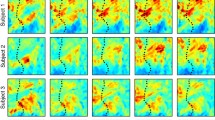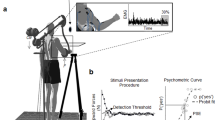Summary
If the form of simple movements as well as the muscles involved are coded by place, it should be possible selectively to fatigue form-specific and muscle-specific neurons, whereby muscle-specific units are supposed to control homologous muscles on both sides of the body. In two experiments both kinds of selective fatigue effects were observed by the use of movements of different forms and with different fingers of both hands. These effects showed up in the variability of movement times only, but not in their mean.
Similar content being viewed by others
References
Bradley, J.V.: Distribution-free statistical tests. Englewood-Cliffs, N.J.: Prentice-Hall 1968
Cohen, L.: Interaction between limbs during bimanual voluntary activity. Brain 93, 259–272 (1970)
Glencross, D.J.: Serial organization and timing in a motor skill. J. Mot. Behav. 2, 229–237 (1970)
Glencross, D.J.: Effector organization and ‘gradation’ of effort. J. Mot. Behav. 4, 263–271 (1972)
Heuer, H.: Über Bewegungsprogramme bei willkürlichen Bewegungen. Berichte aus dem Fachbereich Psychologie der Philipps-Universität Marburg/Lahn, No. 76. Marburg 1979
Hoffmann, K.-P., Stone, J.: Conduction velocity of afferents to cat's visual cortex: A correlation with cortical receptive field properties. Brain Res. 32, 460–466 (1971)
Hubel, D.H., Wiesel, T.N.: Receptive fields, binocular interaction and functional architecture in two nonstriate visual areas (18 and 19) of the cat. J. Neurophysiol. 28, 994–1002 (1965)
Hubel, D.H., Wiesel, T.N.: Receptive fields and functional architecture of monkey striate cortex. J. Physiol. 195,
McKay, D.G., Soderberg, G.A.: Homologous intrusions: An analogue of linguistic blends. Percept. Mot. Skills 32, 645–646 (1971)
Pew, R.W.: Human perceptual motor performance. In: Human information processing: Tutorials in performance and cognition. Kantowitz, B.H. (Ed.). Hillsdale, N.J.: Erlbaum 1974
Rasch, J.P., Burke, R.K.: Kinesiology and applied anatomy. Philadelphia: Lea and Febiger 1974
Robson, J.G.: Receptive fields: Neural representation of the spatial and intensive attributes of the visual image. In: Handbook of perception V, Carterette, F.C., Friedman, M.P. (eds.): New York: Academic Press 1975
Rosenbaum, D.A.: Selective adaptation of ‘command neurons’ in the human motor system. Neuropsychologia 10, 81–91 (1977)
Schmidt, R.A.: A schema theory of discrete motor skill learning. Psychol. Rev. 82, 225–260 (1975)
Stone, J., Freemann, R.B.: Neurophysiological mechanisms in the discrimination of form. In: Handbook of sensory physiology, VII/3: Central processing of visual information, Part A, Jung, R. (ed.). Berlin, Heidelberg, New York: Springer 1973
Author information
Authors and Affiliations
Rights and permissions
About this article
Cite this article
Heuer, H. Selective fatigue in the human motor system. Psychol. Res 41, 345–354 (1980). https://doi.org/10.1007/BF00308879
Received:
Issue Date:
DOI: https://doi.org/10.1007/BF00308879




